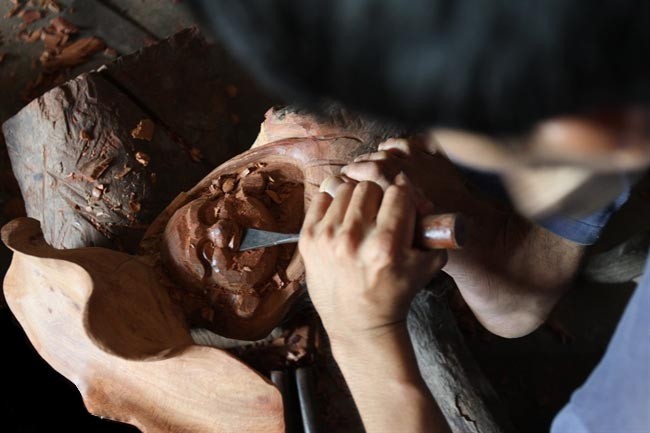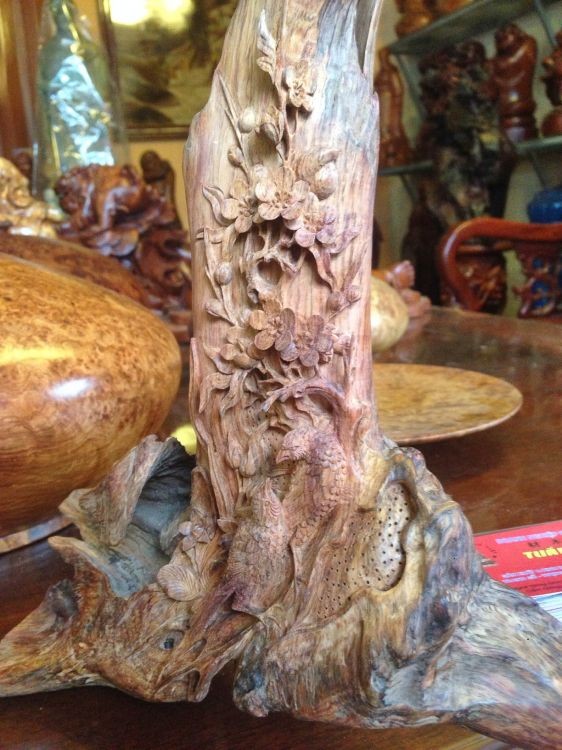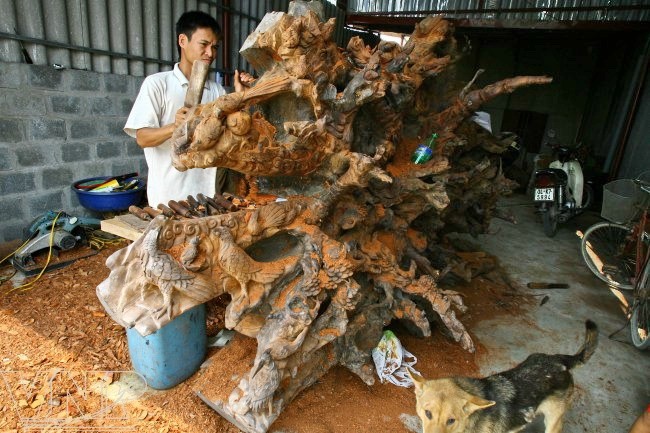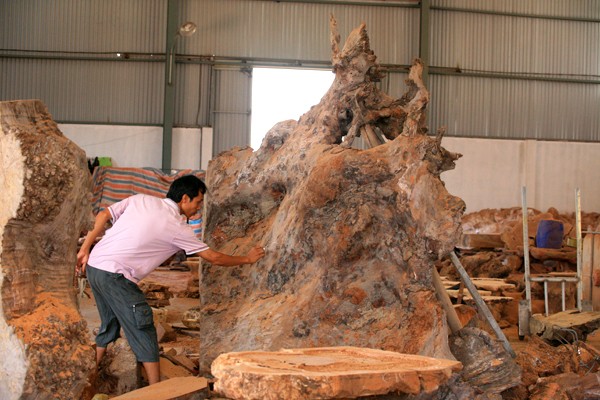Dong Giao Wood Carving Village, nestled in the heart of Vietnam, is a cultural gem that attracts tourists with its rich history and exquisite craftsmanship. SIXT.VN offers seamless travel solutions for those eager to explore this artistic haven and the surrounding areas, from convenient airport transfers to comfortable hotel bookings. Discover the location of this famed village and unlock the door to an unforgettable cultural experience through Vietnam travel and local craftsmanship, enhanced by expert travel planning and cultural immersion.
1. Where Exactly Is Dong Giao Wood Carving Village Situated?
Dong Giao Wood Carving Village is located in Cam Giang district, Hai Duong Province, Vietnam. Approximately 50 kilometers (about 31 miles) east of Hanoi, this village is easily accessible for a day trip or as part of a larger exploration of the region. The craft village is known for its long history of woodworking, dating back more than 300 years.
1.1 What Makes the Location of Dong Giao Ideal for Wood Carving?
The location in Cam Giang district provides access to essential resources and cultural influences that have shaped Dong Giao’s wood carving tradition. The location’s proximity to natural resources and trade routes contributed to its growth and specialization in woodworking.
1.2 How Can I Reach Dong Giao Wood Carving Village from Hanoi?
Reaching Dong Giao Wood Carving Village from Hanoi is straightforward. You can hire a private car, take a bus, or even book a tour. SIXT.VN offers convenient transportation options, including private car services with experienced drivers, ensuring a hassle-free journey to and from the village.
1.3 Are There Any Other Attractions Near Dong Giao Worth Visiting?
Yes, there are several attractions near Dong Giao that are worth visiting. Hai Duong province is rich in cultural and historical sites, including temples, pagodas, and traditional villages. You can also explore the nearby Van Diem wood carving village or take a day trip to the cultural relics of Bac Ninh. Consider a side trip to the renowned Halong Bay, approximately a 2.5-hour drive from Hanoi.
2. What Kind of Wood Carving Products Can I Find in Dong Giao Village?
Dong Giao Wood Carving Village offers a wide array of products, ranging from furniture to worship equipment and fine art pieces. These include traditional furniture items like beds and wardrobes, religious items like thrones and incense tables, and decorative pieces influenced by Western and Southern styles. These are crafted with meticulous care and attention to detail by skilled artisans.
2.1 How Has the Product Range Evolved Over Time?
Over the years, Dong Giao has expanded its product range to include fine art furniture in Western and Southern styles, showcasing its adaptability and innovation. The village now produces cabinets, saunas, and decorative animal carvings, catering to a broader market.
2.2 Are Dong Giao Wood Carvings Exported Internationally?
Yes, Dong Giao wood carvings are exported to many countries in Asia and beyond. The village’s products have gained international recognition for their quality and craftsmanship, making them popular among collectors and enthusiasts worldwide.
2.3 What Types of Wood Are Commonly Used in Dong Giao’s Carvings?
The wood carvings in Dong Giao are crafted from naturally based wood or roots, making each product unique in its artistic shape. Artisans carefully select high-quality wood to ensure the durability and beauty of their creations.
 Wood carving products from Dong Giao village
Wood carving products from Dong Giao village
3. What Is the Historical Significance of Dong Giao Wood Carving Village?
The history of Dong Giao Wood Carving Village dates back to the 17th-19th centuries when skilled workers were summoned to Hue to serve in the royal court. The village has a rich heritage of producing worship and interior decoration items for palaces and temples.
3.1 How Did Dong Giao Wood Carvings Influence Royal Courts?
During the 17th-19th centuries, the skilled artisans of Dong Giao were highly sought after by the royal court in Hue. Their intricate wood carvings adorned palaces and temples, reflecting their significant artistic influence.
3.2 What Traditional Items Were Produced for Worship and Decoration?
Dong Giao artisans traditionally crafted thrones, hammocks, doors, incense altars, cabinets, and wooden statues for worship and interior decoration. These items showcased the skill and creativity of the village’s craftsmen.
3.3 How Has the Historical Legacy Impacted Modern Carving Techniques?
The historical legacy of Dong Giao has significantly influenced modern carving techniques. Contemporary artisans continue to use traditional methods while incorporating new technologies and designs, preserving the village’s cultural identity.
4. Who Are the Artisans Behind Dong Giao Wood Carvings?
Dong Giao workers are known for being clever, smart, and industrious, constantly innovating and improving their designs and skills. They are now adept at applying science and technology to production, creating diverse and rich wood carvings.
4.1 What Skills and Techniques Are Passed Down Through Generations?
Skills and techniques in Dong Giao are passed down through generations, ensuring the preservation of traditional craftsmanship. Young artisans learn from experienced masters, maintaining the village’s reputation for excellence.
4.2 How Do Artisans Incorporate Modern Techniques into Traditional Wood Carving?
Artisans in Dong Giao skillfully incorporate modern techniques into traditional wood carving, blending innovation with heritage. They use advanced tools and technologies to enhance the precision and efficiency of their work.
4.3 Are There Workshops or Demonstrations Available for Visitors?
Many workshops and demonstrations are available for visitors in Dong Giao, offering insights into the intricate process of wood carving. You can observe artisans at work and even participate in hands-on activities.
 Dong Giao artisans at work
Dong Giao artisans at work
5. Why Is Wood Engraving Considered a Special Handicraft?
Wood engraving is a special handicraft because it combines economic value with artistic and cultural significance. Through their craft, artisans portray human aspirations, artistic sense, and the particular civilization of the East.
5.1 How Does Wood Engraving Reflect Cultural and Artistic Values?
Wood engraving reflects cultural and artistic values by showcasing the unique aesthetics and traditions of the region. The intricate designs and motifs used in Dong Giao’s carvings often depict scenes from folklore, history, and nature.
5.2 What Role Does Wood Carving Play in Preserving Eastern Civilization?
Wood carving plays a crucial role in preserving Eastern civilization by transmitting cultural knowledge and values through generations. The craft embodies the artistic expression and historical identity of the region.
5.3 What Makes Dong Giao’s Wood Carvings Unique Compared to Other Regions?
Dong Giao’s wood carvings stand out due to their unique designs, high-quality materials, and exceptional craftsmanship. The village’s long history and cultural influences have shaped its distinctive style, setting it apart from other regions.
6. What Can Visitors Expect When Visiting Dong Giao Wood Carving Village?
Visitors to Dong Giao Wood Carving Village can expect to see a wide range of products carved from naturally based wood or roots, creating unique artistic shapes. You’ll witness the meticulous processing of handicraft products, reflecting the artisans’ skill and dedication.
6.1 What Is the Atmosphere Like in the Village?
The atmosphere in Dong Giao is vibrant and welcoming, with the sounds of wood carving tools and the scent of freshly cut wood filling the air. Visitors can stroll through the village, interact with artisans, and learn about the craft.
6.2 Can Visitors Purchase Wood Carvings Directly from Artisans?
Yes, visitors can purchase wood carvings directly from artisans in Dong Giao, providing an opportunity to support the local economy and acquire unique souvenirs. Bargaining is common, so be prepared to negotiate for the best price.
6.3 Are There Any Cultural Events or Festivals Held in the Village?
Throughout the year, Dong Giao hosts various cultural events and festivals celebrating its wood carving heritage. These events offer visitors a chance to experience traditional music, dance, and other cultural performances.
 Unique wood carvings in Dong Giao
Unique wood carvings in Dong Giao
7. How Can SIXT.VN Enhance My Visit to Dong Giao Wood Carving Village?
SIXT.VN offers a range of services to enhance your visit to Dong Giao, including convenient transportation options, hotel bookings, and tour packages. We ensure a seamless and enjoyable travel experience.
7.1 What Transportation Options Does SIXT.VN Provide?
SIXT.VN provides private car services with experienced drivers, making it easy to reach Dong Giao from Hanoi or other locations. Our transportation options offer comfort and convenience.
7.2 How Can SIXT.VN Help with Hotel Bookings Near Dong Giao?
SIXT.VN can assist with hotel bookings near Dong Giao, offering a variety of accommodations to suit your preferences and budget. We ensure a comfortable stay.
7.3 What Tour Packages Are Available for Exploring Dong Giao and Surrounding Areas?
SIXT.VN offers tour packages that combine a visit to Dong Giao with other attractions in the region, such as Van Diem wood carving village or Bac Ninh’s cultural relics. These packages provide a comprehensive travel experience.
8. What Are the Benefits of Combining a Trip to Dong Giao with Other Local Attractions?
Combining a trip to Dong Giao with other local attractions allows you to experience the rich cultural heritage of the region fully. You can explore multiple aspects of Vietnamese art, history, and traditions in a single trip.
8.1 Why Should I Visit Van Diem Wood Carving Village?
Visiting Van Diem Wood Carving Village offers an opportunity to compare different styles and techniques of wood carving. Each village has its unique characteristics, providing a broader perspective on Vietnamese craftsmanship.
8.2 What Cultural Relics Can I See in Bac Ninh?
Bac Ninh is home to numerous cultural relics, including ancient temples, pagodas, and traditional villages. Exploring these sites offers insights into the region’s historical and religious significance.
8.3 How Can I Plan a Multi-Day Trip Including Dong Giao and Halong Bay?
Planning a multi-day trip including Dong Giao and Halong Bay allows you to combine cultural exploration with natural beauty. You can start with a visit to Dong Giao, then travel to Halong Bay to experience its stunning landscapes and cruises.
 Dong Giao wood carving details
Dong Giao wood carving details
9. What Travel Tips Should I Keep in Mind When Visiting Dong Giao?
When visiting Dong Giao, it’s essential to dress respectfully, bring cash for purchases, and be prepared to bargain. Learning a few basic Vietnamese phrases can also enhance your experience.
9.1 What Is the Best Time of Year to Visit Dong Giao?
The best time of year to visit Dong Giao is during the dry season (October to April) when the weather is pleasant and conducive to outdoor activities. Avoid the rainy season (May to September) to ensure a comfortable trip.
9.2 How Should I Dress When Visiting Religious Sites?
When visiting religious sites in or near Dong Giao, dress modestly by covering your shoulders and knees. Remove your shoes before entering temples and pagodas.
9.3 Is It Safe to Travel Independently in the Area?
Yes, it is generally safe to travel independently in the area. However, it’s always wise to take precautions such as keeping your valuables secure and being aware of your surroundings.
10. How Does Dong Giao Village Contribute to Sustainable Tourism?
Dong Giao Village contributes to sustainable tourism by preserving traditional crafts, supporting local artisans, and promoting cultural heritage. By visiting and purchasing directly from artisans, tourists help sustain the village’s economy and culture.
10.1 How Can Tourists Support Local Artisans and the Village Economy?
Tourists can support local artisans and the village economy by purchasing wood carvings directly from the artisans. This ensures that the money goes directly to the community, helping to sustain their livelihoods.
10.2 What Initiatives Are in Place to Preserve Traditional Craftsmanship?
Various initiatives are in place to preserve traditional craftsmanship in Dong Giao, including training programs for young artisans and support for local workshops. These efforts help ensure that the skills and knowledge are passed down through generations.
10.3 How Can I Ensure My Visit Is Respectful and Sustainable?
To ensure your visit is respectful and sustainable, be mindful of the local culture and traditions, avoid littering, and support local businesses. By traveling responsibly, you can help preserve the beauty and heritage of Dong Giao for future generations.
11. What Recent Developments or Innovations Have Occurred in Dong Giao?
Dong Giao has seen recent developments in applying technology to enhance wood carving techniques, as well as innovations in design to meet contemporary market demands. The blend of traditional and modern approaches ensures the village remains competitive.
11.1 How Has Technology Impacted Wood Carving Techniques?
Technology has enabled artisans to create more intricate and precise designs, improving efficiency and quality. The use of computer-aided design (CAD) and laser cutting has opened new possibilities for wood carving.
11.2 What New Designs Are Emerging to Meet Contemporary Tastes?
New designs are emerging that blend traditional motifs with contemporary aesthetics, appealing to a broader customer base. Artisans are creating minimalist pieces, functional art, and custom designs to meet diverse tastes.
11.3 Are There Any New Export Markets for Dong Giao’s Products?
Dong Giao’s products are finding new export markets in Europe and North America, driven by increased demand for unique, handcrafted items. These new markets present opportunities for growth and expansion.
12. What Are the Most Frequently Asked Questions About Dong Giao Wood Carving Village?
Here are some of the most frequently asked questions about Dong Giao Wood Carving Village:
12.1 What Is Dong Giao Wood Carving Village Known For?
Dong Giao Wood Carving Village is known for its skillful wood carving products and a long history of wood carving dating back more than 300 years.
12.2 How Far Is Dong Giao From Hanoi?
Dong Giao is approximately 50 kilometers (31 miles) east of Hanoi.
12.3 What Types of Products Are Made in Dong Giao?
The village produces furniture, worship equipment, and fine art pieces, including beds, wardrobes, thrones, incense tables, and decorative animal carvings.
12.4 Can I Buy Wood Carvings Directly From Artisans in Dong Giao?
Yes, visitors can purchase wood carvings directly from artisans in Dong Giao.
12.5 What Is the Best Way to Get to Dong Giao From Hanoi?
The best ways to get to Dong Giao from Hanoi include hiring a private car, taking a bus, or booking a tour. SIXT.VN offers convenient transportation options.
12.6 Are There Any Other Attractions Near Dong Giao Worth Visiting?
Yes, nearby attractions include Van Diem wood carving village and the cultural relics of Bac Ninh.
12.7 What Should I Wear When Visiting Dong Giao?
Dress respectfully, especially when visiting religious sites, by covering your shoulders and knees.
12.8 Is It Safe to Travel to Dong Giao?
Yes, it is generally safe to travel to Dong Giao, but take standard precautions like securing your valuables.
12.9 How Can SIXT.VN Help With My Trip to Dong Giao?
SIXT.VN offers transportation, hotel bookings, and tour packages to enhance your visit to Dong Giao.
12.10 What Is the Significance of Wood Carving in Vietnamese Culture?
Wood carving is a significant part of Vietnamese culture, reflecting artistic values, preserving Eastern civilization, and showcasing unique craftsmanship.
Visiting Dong Giao Wood Carving Village offers a captivating glimpse into Vietnam’s rich artistic heritage. With SIXT.VN, planning your trip is effortless, ensuring a seamless and memorable experience. From arranging convenient airport transfers to securing comfortable accommodations and crafting personalized tour packages, SIXT.VN is your trusted partner for exploring the cultural wonders of Vietnam. Discover the artistry and tradition of Dong Giao, and let SIXT.VN take care of all your travel needs. Ready to embark on a cultural adventure? Contact SIXT.VN today at Address: 260 Cau Giay, Hanoi, Vietnam, Hotline/Whatsapp: +84 986 244 358, or visit our website at SIXT.VN to start planning your unforgettable journey. Enhance your cultural immersion, enjoy reliable transportation, and experience the beauty of Vietnam with SIXT.VN.



